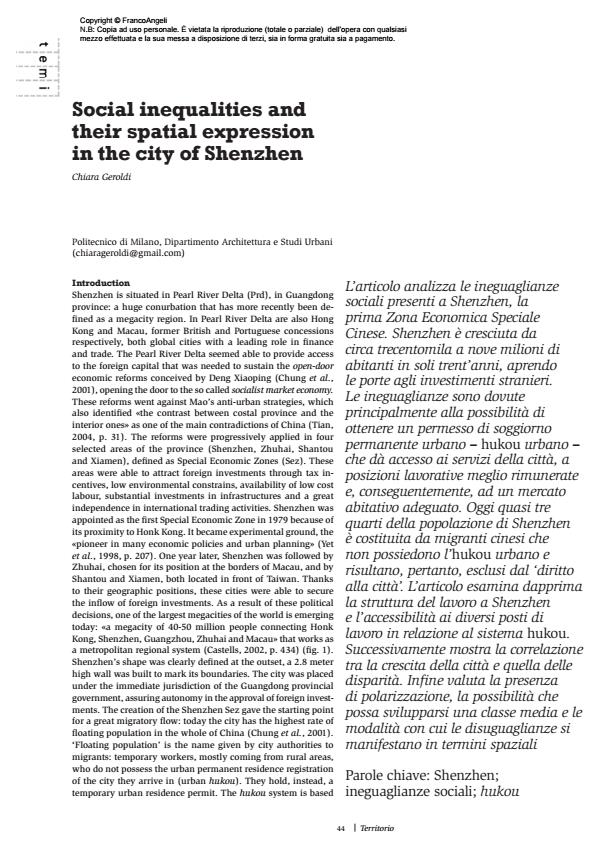Social inequalities and their spatial expression in the city of Shenzhen
Titolo Rivista TERRITORIO
Autori/Curatori Chiara Geroldi
Anno di pubblicazione 2013 Fascicolo 2013/65 Lingua Italiano
Numero pagine 8 P. 44-51 Dimensione file 532 KB
DOI 10.3280/TR2013-065006
Il DOI è il codice a barre della proprietà intellettuale: per saperne di più
clicca qui
Qui sotto puoi vedere in anteprima la prima pagina di questo articolo.
Se questo articolo ti interessa, lo puoi acquistare (e scaricare in formato pdf) seguendo le facili indicazioni per acquistare il download credit. Acquista Download Credits per scaricare questo Articolo in formato PDF

FrancoAngeli è membro della Publishers International Linking Association, Inc (PILA)associazione indipendente e non profit per facilitare (attraverso i servizi tecnologici implementati da CrossRef.org) l’accesso degli studiosi ai contenuti digitali nelle pubblicazioni professionali e scientifiche
This paper examines social inequalities present in Shenzhen, the China’s first ‘Special Economic Zone’. Shenzhen has grown from three hundred thousand to nine million inhabitants in just thirty years, opening its doors to foreign investment. The inequalities are due mainly to the possibility of acquiring a permanent urban stay permit - an urban hukou - which gives access to city services, better paid work and consequently an adequate housing market. Today almost three quarters of the population of Shenzhen consists of Chinese migrants who do not possess an urban hukou and are therefore excluded from the ‘right to the city’. The paper looks firstly at the labour market structure in Shenzhen and access to jobs in relation to the hukou system. It then shows the correlation between the growth of the city and the increase in inequalities. Finally, it assesses the presence of polarisation, the possibility of a middle class emerging and the ways in which inequalities manifest in spatial terms.;
Keywords:Shenzhen; social inequalities; hukou
- Castells M., 2002, The Rise of Network Society, Blackwell, Oxford. Chung C.J., Inaba J., Koolhaas R., Leong S.T, 2001, Great Leap Forward.
- Harvard Design School Project on the City, Harvard Design School, Cambridge, Mass.
- Dai E., 2007, «Migrants, Employment Discrimination and Income Inequal- ity in Urban China: A Case Study of Shenzhen», The Economic Science, vol. 55, n. 3, pp. 85-100.
- Elfick J., 2011, «Class Formation and Consumption among Middle-Class professionals in Shenzhen», Journal of Current Chinese Affairs, vol. 40, n. 1, pp. 187-211.
- Gravemeyer S., Gries T., Xue J., 2008, Discrimination, Income Determi- nation and Inequality, the Case of Shenzhen, Center for International Economics, working paper series, pp. 1-18.
- Hamnett C., 1994, «Social Polarization in Global Cities: Theory and Evidence», Urban Studies, vol. 31, n. 3, pp. 401-424, DOI: 10.1080/00420989420080401
- Hao P., 2009, Open Villages within the Exclusive City: an Empirical Study on Urban Villages in Shenzhen, China (www.n-aerus.net/web/sat/ workshops/2009/Rotterdam/pdf/Hao_etal.pdf).
- Hao, P., Sliuzas, R., Geertman, S., 2011, «The Development and Redevel- opment of Urban Villages in Shenzhen», Habitat International, vol. 35, pp. 214-224, DOI: 10.1016/j.habitatint.2010.09.001
- Hornsby A., Mars N., 2008, The Chinese Dreams, a Society Under Con- struction, 010 Publisher, Rotterdam.
- Lin, D., Li, X., Wang, B., Hong, Y., Fang, X., Qin, X., Stanton B., 2011, «Discrimination, Perceived Social Inequity, and Mental Health Among Rural-to-Urban Migrants in China», Community Ment Health J, vol. 47, pp. 171-180, DOI: 10.1007/s10597-009-9278-4
- Musterd S., 2005, «Social and Ethnic Segregation in Europe: Levels, Causes and Effects», Journal of Urban Affairs, vol. 27. n. 3, pp. 331-348, DOI: 10.1111/j.0735-2166.2005.00239.x
- Sassen S., 2000, Cities in a World Economy, Pine Forge press, Thousand Oaks. Shenzhen Statistic Bureau, 2010, Shenzhen Statistical Yearbook, China Statistic Press, Hong Kong.
- Tian H., 2004, The Development of the Contested City form of Shenzhen, China, thesis, Master of Science in Architecture Studies, Massachusetts Institute of Technology, Cambridge, pp. 26-71.
- Yang, H., Tian, L., Van Oudenhoven, J. P., Hofstra, J., Wang, Q., 2010, «Urban Residents’ Subtle Prejudice towards Rural-To-Urban Migrants in China: The Role of Socio-economic Status and Adaptation Styles», Journal of Community & Applied Social Psychology, vol. 20, pp. 202-216.
- Yeh A. G., Wu F., 1998, «The Transformation of the Urban Planning System in China from a Centrally Planned to Transitional Economy», Progress in Planning, vol. 51, pp. 165-252.
- Zaho F., 2009, The Community - Based Partnership Approach for Affordable Housing Development: A Case in Shenzhen, China, thesis, Master of Science in Architecture Studies, Massachusetts Institute of Technology, Cambridge, pp. 53-62.
- Zhu J., 1996, «Denationalization of Urban Physical Development. The Experiment in the Shenzhen Special Economic Zone, China», Cities, vol. 13, n. 3, pp. 187-194, DOI: 10.1016/0264-2751(96)00005-4
Chiara Geroldi, Social inequalities and their spatial expression in the city of Shenzhen in "TERRITORIO" 65/2013, pp 44-51, DOI: 10.3280/TR2013-065006